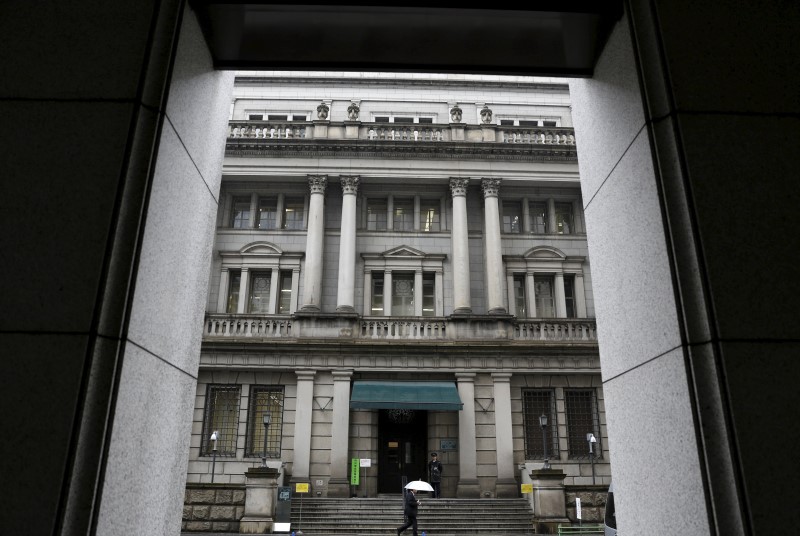(Bloomberg) -- Japan’s 10-year yield climbed to 0.1 percent, the highest in more than a year, as speculation that the central bank may discuss adjusting its ultra-loose monetary policy next week continued to rattle the bond market.
The benchmark yield has more than doubled from last Friday as media reports suggested that Bank of Japan officials are debating ways to mitigate the side effects of its policy on lenders. The yield continued to rise even after the BOJ signaled its intention to cap the advance by offering to buy an unlimited amount of bonds on Monday. It didn’t make such an offer on Thursday.
The speculation around BOJ’s policy has roiled global markets this week, causing yield curves in Japan and other countries including the U.S. and Australia to steepen as traders hedged against the possibility of the Asian nation’s bond funds pivoting home. Any change to BOJ’s policy would be the first since September 2016, when it began the yield curve control.
"The BOJ probably refrained from stepping in to conduct a fixed-rate operation as the 10-year yield didn’t go over 0.1 percent decisively,” said Hidenori Suezawa, chief bond strategist at SMBC Nikko Securities Inc. “Volatility was lower today compared with Monday. The BOJ acted then as the yield had jumped sharply and abruptly.”
The 10-year yield was up two basis points at 0.085 percent as of 4:05 p.m. in Tokyo. It rose as much as 3.5 basis points earlier to 0.1 percent, the first time since July last year, according to data from the Japan Bond Trading Co. The yen was 0.2 percent higher to 110.71 against the dollar.
Testing BOJ
The yield pared its advance even as the BOJ refrained from conducting another fixed-rate operation to try and tame markets. Monday was only the fifth time the central bank offered to buy an unlimited amount of bonds since the introduction of the YCC. Only one operation in February 2017 led to purchases.
Traders may be testing if the BOJ is indeed leaning toward allowing the 10-year yield to be more flexible, said Makoto Suzuki, senior bond strategist of Okasan Securities Group in Tokyo.
The driver for the yield gain on Thursday may have been a new Jiji report. The BOJ may raise the threshold for its fixed-rate operations, while retaining its zero percent target, Jiji had said overnight, according to a Mitsubishi UFJ Morgan Stanley (NYSE:MS) Securities Co. report.
At BOJ’s July 30-31 review, officials will discuss ways to keep their stimulus program sustainable while reducing the harm it causes in markets and to the profitability of commercial banks, earlier reports from Reuters, Asahi and Bloomberg have indicated.
Stealth Tapering
“We think they might do something, but nothing that’s going to upset the JGB market to any great extent,” said Craig Vardy, BlackRock Inc (NYSE:BLK).’s head of fixed income, Australia.
The BOJ could allow the 10-year bond yield more scope to move from the zero percent that it has targeted, while another option would be to change the wording on a target of increasing holdings of sovereign bonds by 80 trillion yen ($723 billion) a year, he said.
The BOJ has already been conducting “stealth tapering” by slowly cutting bond purchases over time. It added slightly less than 50 trillion yen worth of securities to its balance sheet in the year through March.
The dilemma for Governor Haruhiko Kuroda is that even as calls to adjust policy grow louder, persistently weak inflation dictates the need to maintain stimulus. Winding it back would strengthen the yen, further undermining efforts to spur price-gains, while also hitting Japanese exporters.
While Kuroda and his board have said they would consider discussing an exit from the stimulus policy from fiscal 2019, they have also consistently reiterated that there would be no change until the BOJ’s inflation target of 2 percent has been reached.
“If the BOJ wants to lighten the side effects of its own stimulus, then it will most likely move to a direction to push longer-dated JGB yields higher,” said Tsuyoshi Ueno, a Tokyo-based senior economist at NLI Research Institute, a unit of Nippon Life Insurance. U.S. Treasuries will become the biggest casualty if long-dated bond JGB yields actually start climbing, given the already-high cost of hedging dollar investments, he said.
